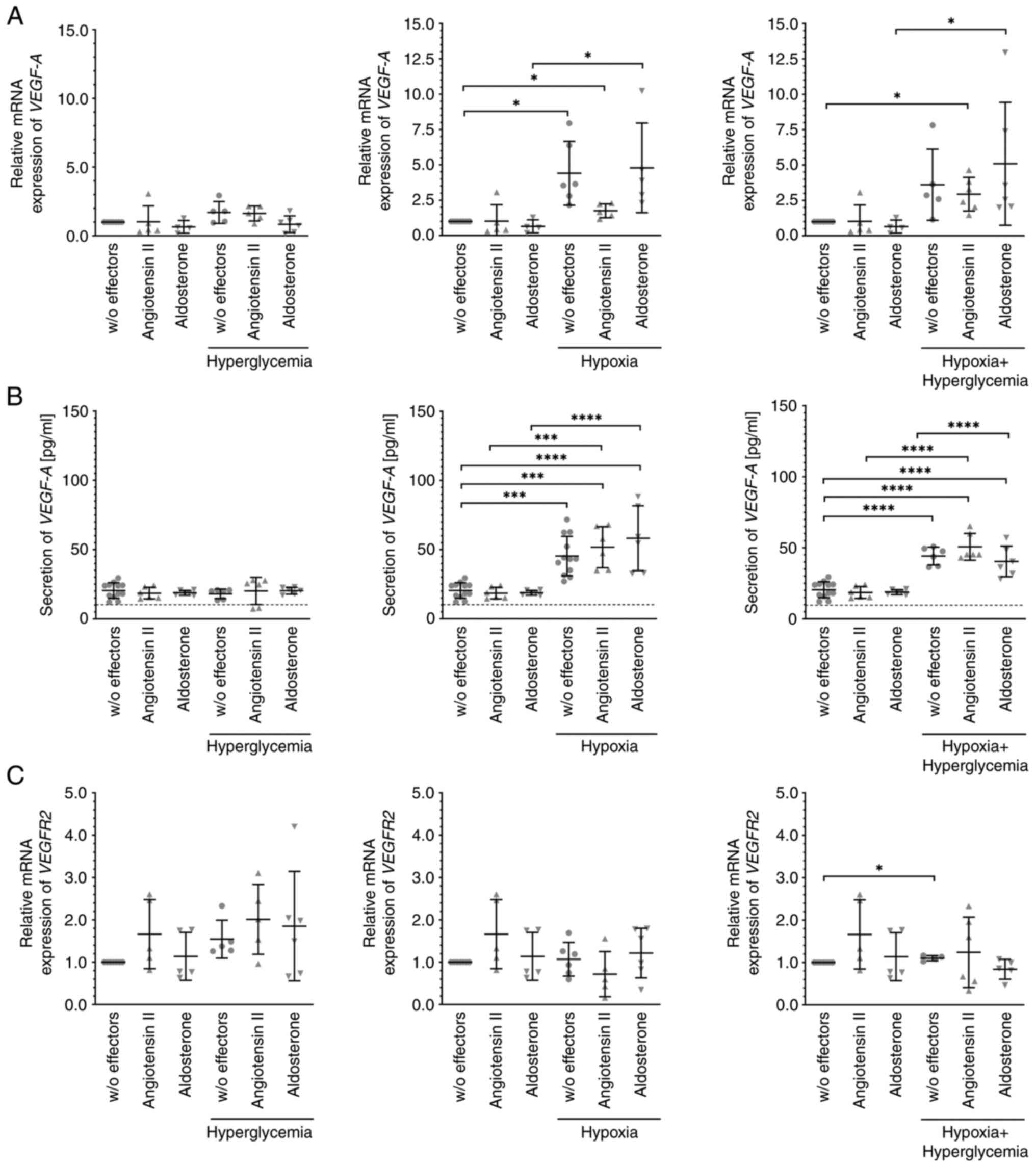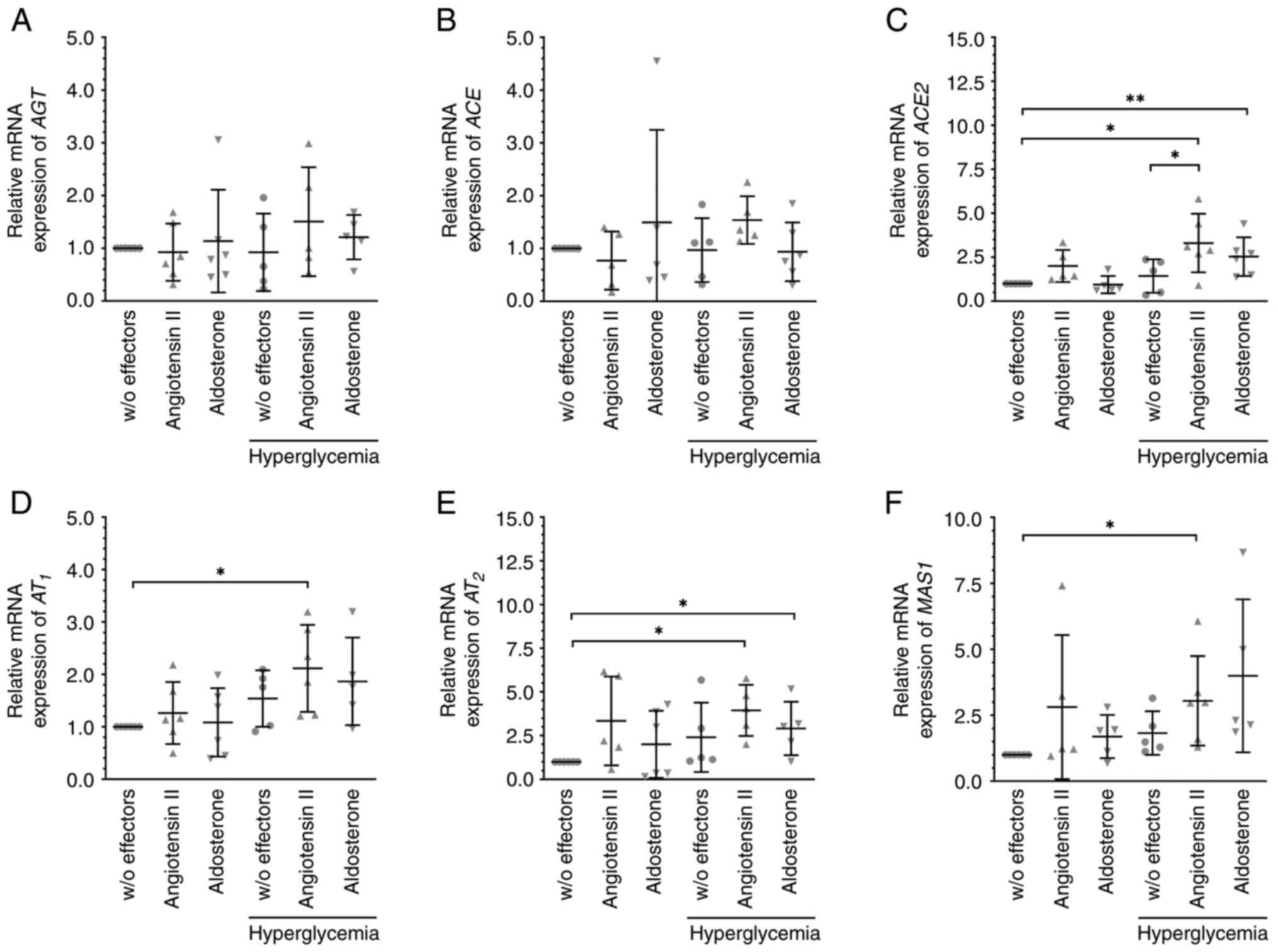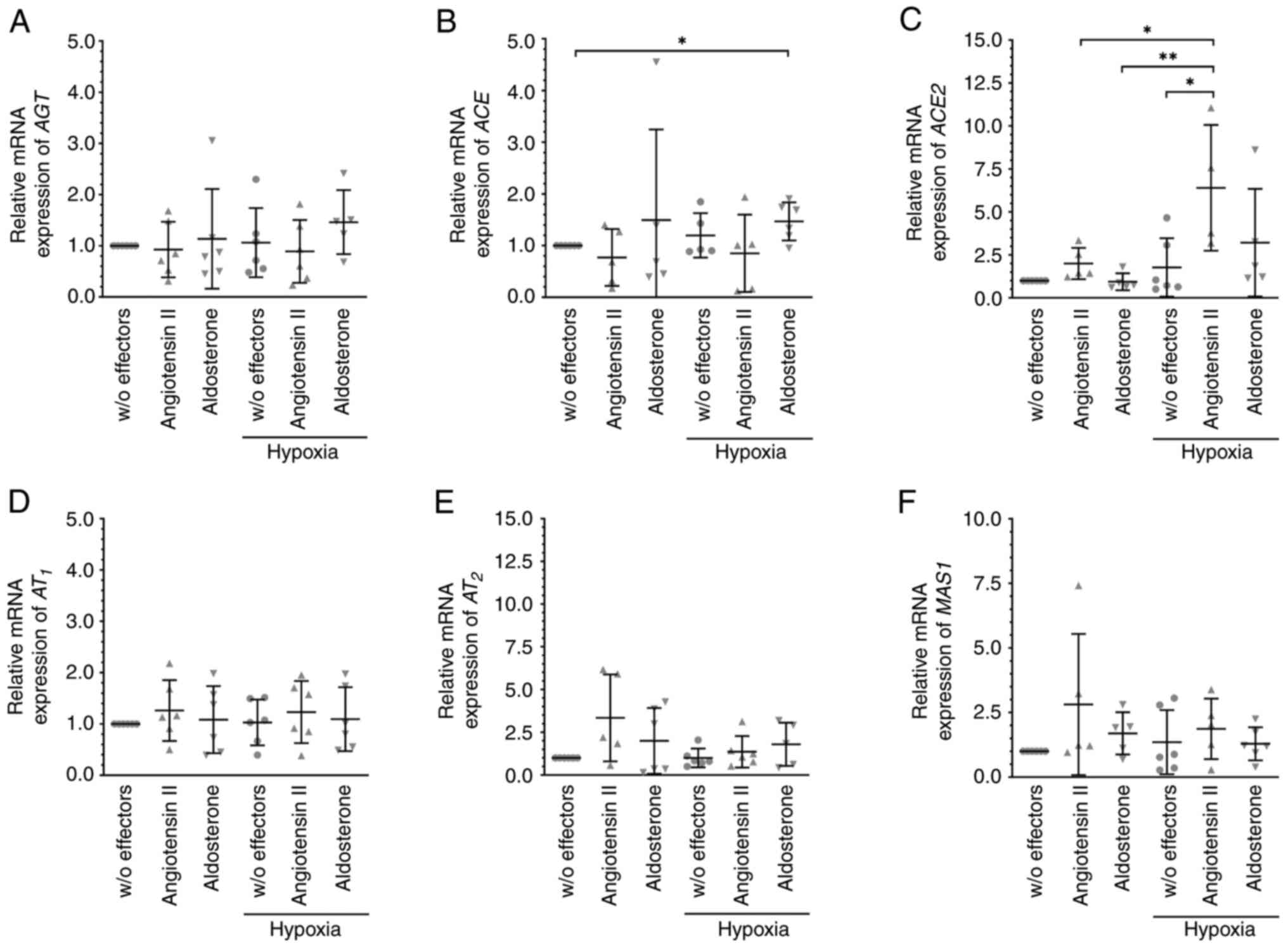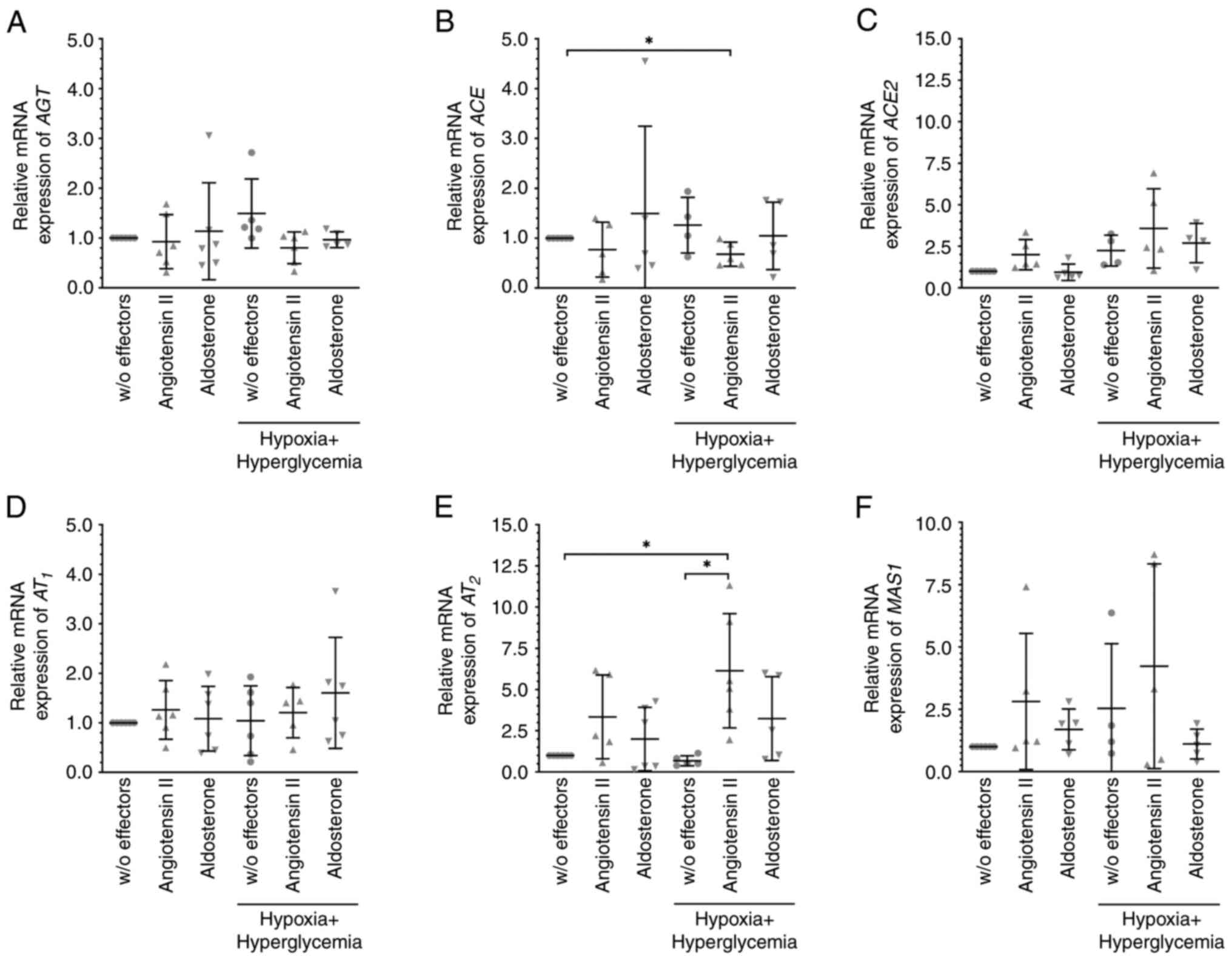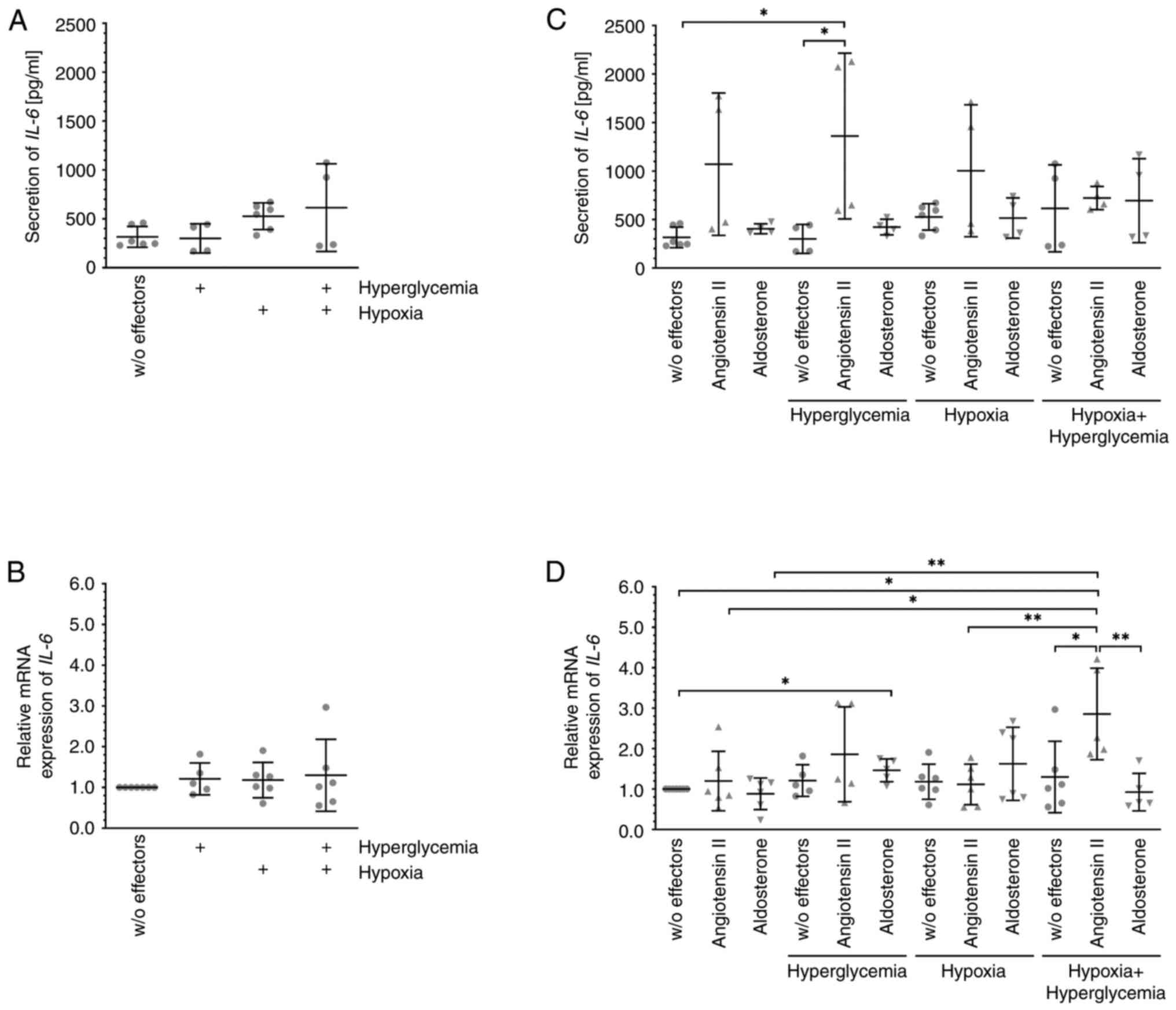Different responses of the MIO‑M1 Mueller cell line to angiotensin II under hyperglycemic or hypoxic conditions
- Authors:
- Published online on: August 7, 2023 https://doi.org/10.3892/br.2023.1644
- Article Number: 62
-
Copyright: © Beuse et al. This is an open access article distributed under the terms of Creative Commons Attribution License.
Abstract
Introduction
Diabetic macula edema (DME) is a serious complication of diabetic retinopathy (DR) occurring in ~3.7% of DR patients, and, based on the estimated worldwide prevalence of diabetes of 5.4% by 2025 an exponential growth of DME and associated loss of vision is expected (1,2). In addition, retinal vein occlusion (RVO) results in hypoxia of the retina and eventually in the development of macular edema (3). Elevated permeability of the retinal endothelium and a decreased re-uptake of fluid by Mueller cells, which express multiple ion- and water-channels (such as Na+-, K+-, and aquaporin channels) leads to the accumulation of fluid in the macula (4). Decreased expression of ion channels results in deregulated trans-glial water transport and as a consequence in the swelling of retinal glial cells (4). Vascular endothelial growth factor A (VEGF-A), higher levels of which are present in the vitreous of patients with DR, DME, or RVO, elevates the permeability of the retinal endothelium, playing a key role in the pathophysiology of macular edema (3-7). Higher concentrations in the vitreous or aqueous humor of inflammatory cytokines, such as interleukin (IL)-6 and IL-1β are not only associated with the pathogenesis of RVO, respectively, but also with the development of DME and proliferative DR (8-12). Additionally, the ocular renin-angiotensin aldosterone-system (RAAS) also regulates the retinal blood and fluid balance; several studies point to its major role in the development of DME (13-15). Members of the RAAS, including angiotensinogen (AGT), angiotensin-converting enzyme (ACE), and ACE2 as well as the receptors of angiotensin II, AT1, and AT2, encoded by the genes AGTR1 and AGTR2, respectively, and the G-protein-coupled receptor MAS1 of angiotensin (1-7), are expressed by retinal tissues including Mueller cells and retinal vessels (16-25). AGT is cleaved by the protease renin to give rise to angiotensin I and cleavage of the decapeptide by ACE in turn results in the vasoconstrictive octapeptide angiotensin II. This peptide hormone not only induces pro-inflammatory responses but may also be involved in angiogenesis, and these processes are mediated by its receptor AT1 (13,25). Through its weakly expressed alternative receptor AT2, the actions of angiotensin II can be counteracted (25,26). The G-protein-coupled receptor MAS1 induces anti-angiogenic and anti-inflammatory processes not only systemically but also in the retina; its ligand, the vasodilator angiotensin (1-7), is formed by the proteolytic removal of the C-terminal phenylalanine of angiotensin II by ACE2 (24,27).
Taken together, upregulation of AGT can lead to increased production of angiotensin II resulting in higher local RAAS activity in general; however, the consequences of its actions on Mueller cells and the retina in its entirety are not fully understood. Thus, the influence of angiotensin II or aldosterone on the expression of different mediators of DME or RVO pathogenesis, as well as the components of the RAAS under hypoxic and hyperglycemic conditions in MIO-M1 cells, a model of human Mueller cells, were investigated (28,29).
Materials and methods
Culture and treatment of MIO-M1
The spontaneously immortalized human Mueller glial cell line MIO-M1 (RRID: CVCL_0433) was purchased from University College London (28). Cells were cultured in DMEM (cat. no. 21885025, Thermo Fisher Scientific, Inc.) containing 5 mM glucose, and supplemented with 10% FBS, glutamax II, and penicillin/streptomycin (all purchased from Thermo Fisher Scientific, Inc.) at 37˚C and 5% CO2. To confirm absence of mycoplasma, fixed MIO-M1 cells were regularly stained with DAPI (λexcitation/λemmission=359 nm/461 nm) and evaluated using fluorescence microscopy, which would have enabled the detection of non-nuclear DNA, which would have indicated the possible presence of mycoplasma. To study the changes induced by 30 mM glucose (Carl Roth), 10 nM angiotensin II (cat. no. 05-23-0125, MilliporeSigma), 10 nM aldosterone (cat. no. A9477, MilliporeSigma), and hypoxia (0.1% O2) or their combinations, 4x104 MIO-M1 cells were seeded per well of a 12-well cell culture plate (Greiner Bio-One) in 1 ml DMEM supplemented with 10% FBS, glutamax II, and penicillin/streptomycin. When ~90% of the cell culture surface was covered by a monolayer of cells, the cell culture medium was replaced with serum-free DMEM. After further culture for 16 h, glucose, angiotensin II or aldosterone were added in a volume of 10 µl DMEM, and cells were incubated for an additional 6 h before cell culture supernatants and cells were harvested.
RNA isolation and cDNA synthesis
The InviTrap Spin Universal RNA Mini Kit (cat. no. 1060100200 Stratec Molecular) was used to isolate total RNA. The quality of the RNA samples was analyzed using a NanoDrop 1000 spectrophotometer (Peqlab). The A260/A280 ratio was between 1.95 and 2.05 demonstrating a sufficiently good quality of the RNA samples. Possible contamination with DNA was removed with recombinant RNAse-free DNase I (cat. no. 4716728001, MilliporeSigma). cDNA synthesis was performed using 0.6 µg total RNA and a RevertAid H Minus First Strand cDNA Synthesis Kit, according to the manufacturer's protocol (Thermo Fisher Scientific, Inc.).
Quantitative (q)PCR
Semi-quantitative PCR was performed using a CFX Connect Real-Time PCR System (Bio-Rad Laboratories, Inc.). The sequences of the primers used in the present study are listed in Table I. The amplification mixture (10 µl in total) contained 5 µl iQ™ SYBR® Green Supermix (cat. no. 170888x, Bio-Rad Laboratories, Inc.), specific primers (0.2 µM each), and 1 µl (~0.1 µg) of cDNA. The PCR amplification conditions were: Initial denaturation and enzyme activation at 95˚C, 3 min; followed by 45 cycles of denaturation at 95˚C for 30 sec, annealing at 58˚C for 20 sec, and extension at 72˚C for 45 sec. Each measurement included a melting curve analysis in the range of 65-95˚C with an increment of 0.5 K, and the length of the PCR products was determined by standard agarose gel electrophoresis. mRNA expression of actin (ACTB) was used for normalization and relative mRNA levels were calculated using the 2-ΔΔCq method: ΔCq=Cqtarget gene-CqACTB and ΔΔCq=ΔCqtreatment-ΔCqcontrol (30).
Determination of secreted VEGF-A or IL-6
The concentration of VEGF-A or IL-6 in cell culture supernatants of the treated MIO-M1 cells were determined using a Quantikine human VEGF-A ELISA kit (cat. no. DVE00, Bio-Techne) and a Quantikine Human IL-6 ELISA kit (cat. no. DVE6050, Bio-Techne), respectively. For measuring IL-6 levels, samples were diluted 1:10 in PBS without Ca2+- and Mg2+-ions (cat. no. 14190-169, Thermo Fisher Scientific, Inc.), and undiluted samples were used to determine the concentration of VEGF-A. Duplicate samples were processed according to the manufacturer's instructions and the analyte-dependent absorbance at 450 nm (reference wavelength: 570 nm) was measured 15 min after the addition of the stop solution with an Infinite 200Pro M Nano spectrophotometer controlled by Tecan I control software (version 2.0.10.0; Tecan Group, Ltd.). Standard curves (16 pg/ml to 1 ng/ml VEGF-A or 3-300 pg/ml IL-6) were always generated in parallel to the analysis of samples.
Statistical analysis
All experiments were performed at least three times. A one-way ANOVA followed by a Tukey's post-hoc test was used to compare the RT-qPCR signals from the treated cells and the ELISA results. For comparison of RT-qPCR signals from treated cells to the hypothetical value of 1 (normalized to the signal of control cells), a one-sample t-test was used, as in this type of statistical analysis, the variability of the values obtained from control cell signals is taken into consideration, although they appear without standard deviations (SD=0). P#x003C;0.05 was considered to indicate a statistically significant difference. All statistical analyses were performed in GraphPad Prism version 9 (GraphPad Software, Inc.); means and standard deviations are provided as numbers or as scatter plots.
Results
Angiotensin II and aldosterone do not alter the expression of VEGF-A or VEGFR2 in MIO-M1 cells
Unchallenged MIO-M1 cells expressed or secreted considerable quantities of VEGF-A mRNA (Fig. 1A) or protein (Fig. 1B), respectively, and this was not significantly altered after treatment of the cells with 30 mM glucose, 10 nM angiotensin II, 10 nM aldosterone, or combinations thereof. Expression of VEGF-A mRNA and, accordingly, secretion of this growth factor was substantially and significantly higher after exposure of the cells to hypoxic or hypoxic plus hyperglycemic conditions. Again, these levels were not significantly altered by additional exposure of the cells to angiotensin II or aldosterone. Similarly, expression of VEGFR2 mRNA (Fig. 1C) remained stable. Only after culture of the cells under hypoxic plus hyperglycemic conditions, was its expression weakly but significantly higher.
Angiotensin II and aldosterone treatment alters the expression of RAAS members
When cells were cultured under standard conditions, the mRNA levels of members of the RAAS, AGT (Fig. 2A), ACE (Fig. 2B), the receptors of angiotensin II AT1 (Fig. 2D) and AT2 (Fig. 2E), and the receptor of angiotensin (1-7) MAS1 (Fig. 2F) were not significantly changed by additional treatment with angiotensin II or aldosterone. Exposure of the cells to 30 mM glucose did not alter their expression. However, the mRNA levels of AT1 (Fig. 2D), AT2 (Fig. 2E), and MAS1 (Fig. 2F) were elevated after treatment with angiotensin II under hyperglycemic conditions. These conditions also resulted in significantly enhanced expression of ACE2 (Fig. 2C), which also tended to be higher after angiotensin II exposure under normal conditions.
Cells were cultured under hypoxic conditions (at 0.1% O2), which by itself did not affect the mRNA expression levels of the members of the RAAS (Fig. 3); however, additional treatment with angiotensin II significantly enhanced the expression of ACE2 mRNA (Fig. 3C) under these conditions. Angiotensin II-induced significantly higher mRNA expression of AT2 when MIO-M1 cells were cultured under hypoxic plus hyperglycemic but not under hypoxic conditions (normalized expression levels were: 1.36±0.92 for hypoxia + angiotensin II compared to 6.14±3.47 for hypoxia plus hyperglycemia + angiotensin II, P=0.0029; n=6 per condition; Figs. 3E and 4E). The levels of AT2 mRNA did not differ from the elevated levels observed when MIO-M1 cells were cultured in the presence of 30 mM glucose (normalized expression levels were: 3.94±1.47 for hyperglycemia + angiotensin II, n=5; compared to 6.14±3.47 for hypoxia plus hyperglycemia + angiotensin II, n=6 per condition; P>0.05; Figs. 2E and 4E). Under hypoxic plus hyperglycemic conditions, angiotensin II treatment also resulted in significantly reduced expression of ACE mRNA (Fig. 4B). Similar to angiotensin II, aldosterone-induced significantly higher levels of ACE2 mRNA (Fig. 2C) as well as of angiotensin II receptor AT2 mRNA (Fig. 2E) levels under hyperglycemic conditions. Slightly, but significantly elevated levels of ACE mRNA (Fig. 3B) were observed after exposure of MIO-M1 cells to aldosterone under hypoxic conditions; the expression levels of the other targets remained unchanged throughout.
Angiotensin II alters the expression and secretion of IL-6 depending on the environment
As previously reported by others, unchallenged MIO-M1 cells secrete substantial amounts of the pro-inflammatory cytokine IL-6 (Fig. 5A) (31). However, neither its secretion (Fig. 5A) nor the expression of the corresponding mRNA (Fig. 5B) was altered after exposure of the cells to hyperglycemia, hypoxia, or a combination of both. Both hormones also did not change IL-6 mRNA expression (Fig. 5D) in MIO-M1 cells cultured under normoxic or hypoxic conditions, and secretion (Fig. 5C) of the encoded protein also remained relatively unchanged. During exposure to angiotensin II under hyperglycemic conditions, MIO-M1 cells secreted significantly more IL-6 (Fig. 5C), and the mRNA expression (Fig. 5D) of the cytokine also tended to be higher. Under hypoxic plus hyperglycemic conditions, substantially and significantly more IL-6 mRNA (Fig. 5D) was expressed after additional exposure of the cells to angiotensin II and cells also secreted more IL-6 (Fig. 5C), although the difference was not significant. Aldosterone treatment of MIO-M1 cells under hyperglycemic conditions resulted in slightly, but significantly enhanced expression of IL-6 mRNA (Fig. 5D), but secretion of the cytokine (Fig. 5C) remained unchanged.
Discussion
Confirming previously published data, it was shown that the human cell line MIO-M1, an accepted model of human Mueller cells, expresses AGT, ACE, ACE2, angiotensin II receptors AT1 and AT2, as well as the receptor of angiotensin (1-7) MAS1 (17-19,21-24,28). The mRNA expression levels of these were largely unchanged when cells were exposed to hyperglycemic or hypoxic conditions or both. Exposure of cells to these conditions seemed to not result in induction of cellular stress, which may adversely affect the outcome of the investigations, since expression of IL-6 mRNA, a marker of cellular stress, remained stable. It could be suggested that an incubation time of 6 h is too short, but due to the short half-life of angiotensin II, longer exposure times would likely not result in more relevant data. However, expression and secretion of VEGF-A were substantially increased by hypoxia alone or in combination with hyperglycemia confirming the expected strong response of the cells to their altered environment within the studied time span. Angiotensin II and aldosterone did not modulate VEGF-A levels, proving the dominant role of hypoxia in the regulation of the growth factors' expression and secretion. It was to be expected that hyperglycemia alone did not modulate VEGF-A expression and secretion within 6 h, as possible changes likely manifest only after extended exposure (32). VEGF receptors are expressed in various retinal tissues including the retinal vasculature, Mueller cells, and the retinal pigment epithelium (33,34). Upregulation of VEGFR2 in the retinal vasculature is associated with the development of DR and its activation by the ligand VEGF-A165 results in elevated permeability of retinal endothelial cells or increased expression of pro-inflammatory mediators in Mueller cells in vitro (29,34,35). Inhibitors of ACE and/or AT1, at least in part, prevent VEGF-A165-induced permeability of retinal endothelial cells in vitro and in vivo as well as retinal neovascularization, thereby proving an interaction between both signaling pathways (36-39). However, expression and secretion of VEGF-A by MIO-M1 cells were not altered by angiotensin II likely reflecting the different behaviors of both cell types.
mRNAs coding for proteins of the RAAS indeed exhibited differential expression patterns in the presence of either angiotensin II or aldosterone when cells were cultured under hyperglycemic and/or hypoxic conditions. It is of interest, that angiotensin II did not alter the expression of its precursor AGT under any of the tested conditions, which may indicate that the peptide hormone cannot, directly or indirectly, induce its own expression in Mueller cells. To assess a possible pro-inflammatory response of Mueller cells, the changes in the expression of mRNA as well as secretion of the pro-inflammatory cytokine IL-6, which is constitutively expressed by this cell type (including MIO-M1 cells), was assessed (31). However, under normoxic or hypoxic conditions, the amounts of the secreted cytokine and its mRNA expression levels were not significantly altered by the treatment with angiotensin II or aldosterone, suggesting that the hormones do not induce a pro-inflammatory response of the cells under these circumstances. Interestingly, aldosterone significantly enhanced the expression of ACE mRNA under hypoxic conditions, thus not resulting in an inflammatory response, that is enhanced expression or secretion of IL-6 via the angiotensin II/AT1-axis. Angiotensin II, on the other hand, increased the expression of ACE2, resulting in its own inactivation by the formation of angiotensin (1-7), which does not activate AT1. Similar to the behavior of endothelial cells from the human umbilical cord, the mRNA expression levels of IL-6 were increased in MIO-M1 cells exposed to hyperglycemia and aldosterone, although the amount of the secreted cytokine remained unchanged from control cells (40). However, increased IL-6 expression is likely independent of the angiotensin II/AT1-axis, as possibly endogenously produced peptide hormone is inactivated by high levels of ACE2.
Although angiotensin II did not significantly increase IL-6 mRNA expression in MIO-M1 cells cultured under hyperglycemic conditions, more IL-6 was secreted under these conditions. Higher expression of AT1 mRNA could lead to stronger activation of the pro-inflammatory angiotensin II/AT1 signaling cascade, similar to that observed for angiotensin II-activated retinal microglia, which express higher quantities of various pro-inflammatory cytokines and chemokines including IL-6, a process that is mediated by AT1 (41). Elevated permeability of retinal endothelial cells due to IL-6-mediated trans-signaling in vitro likely contributes to the breakdown of the inner blood-retina barrier in vivo (42). The protective ACE2/angiotensin (1-7)/MAS1 signaling cascade is upregulated during acute and chronic diseases of the heart or kidney to counteract detrimental processes (43,44). This signaling cascade seems to also be activated by Mueller cells exposed to hyperglycemia and angiotensin II, as expression of ACE2 and MAS1 RNA was elevated. Thus, the concentrations of the vasodilator angiotensin (1-7) formed by protease ACE2 may be higher, and through its interaction with receptor MAS1, anti-angiogenic and anti-inflammatory processes can be induced (24-27). However, as MIO-M1 cells secreted increased quantities of IL-6 when exposed to hyperglycemia and angiotensin II, the pro-inflammatory axis seems to exceed the anti-inflammatory response. A similar inflammatory response to angiotensin II was also observed after additional exposure of the cells to hyperglycemia plus hypoxia, as the expression of IL-6 mRNA was substantially upregulated. However, the observed lower expression of ACE mRNA is in line with an assumed capacity of MIO-M1 cells to counteract angiotensin II-induced pro-inflammatory signaling.
In vivo, Mueller cells, retinal endothelial cells, and retinal pericytes form the so-called neurovascular unit, which tightly regulates vascular homeostasis in the retina (45). Whether the cellular interactions change their individual responses to angiotensin II could not be evaluated in the present study. However, inhibitors of ACE or AT1 were found to, at least in part, improve the outcomes of DME in diabetic patients, which supports the findings of the present study that Mueller cells likely contribute to angiotensin II-mediated inflammatory responses present in the early development of this disease (46,47). In contrast, the impact of Mueller cells on angiotensin II-mediated inflammatory responses observed in the early development of RVO is likely low when hypoxia plays a dominant role accompanied by induction of expression and secretion of the angiogenic and permeability-inducing growth factor VEGF-A (9).
In conclusion, the results of the present in vitro study provide evidence that the responses of Mueller cells to activation of the RAAS by angiotensin II depend on the environment: A pro-inflammatory response is observed under hyperglycemic (plus hypoxic) conditions, whereas changes induced by hypoxia are not modulated by angiotensin II.
Acknowledgements
We would like to thank Mr Julian S. Pottier (Leipzig, Germany) for their editorial support and linguistic revision of the manuscript. We would also like to thank Mrs Ute Weinbrecht (Department of Ophthalmology, University of Leipzig, Germany) and Ms Stefanie Wölfel (Department of Ophthalmology, Justus Liebig University, Giessen, Germany) for their excellent technical assistance.
Funding
Funding: No funding was received.
Availability of data and materials
The datasets used and/or analyzed during the present study are available from the corresponding author on reasonable request.
Authors' contributions
CB and MR designed the general concept of the study; specific experimental conditions were established by AB, MH, HLD, and CB. AB and MH performed the experiments. AB, CB, MH, HLD, JDU curated and analyzed the data. AB, CB, MH, and HLD wrote the original draft manuscript. All authors reviewed and edited the manuscript. JDU and MH provided resources. All authors have read and approved the final manuscript. CB and HLD confirm the authenticity of the raw data.
Ethics approval and consent to participate
Not applicable.
Patient consent for publication
Not applicable.
Competing interests
The authors declare that they have no competing interest.
References
|
Li JQ, Welchowski T, Schmid M, Letow J, Wolpers C, Pascual-Camps I, Holz FG and Finger RP: Prevalence, incidence and future projection of diabetic eye disease in Europe: A systematic review and meta-analysis. Eur J Epidemiol. 35:11–23. 2020.PubMed/NCBI View Article : Google Scholar | |
|
King H, Aubert RE and Herman WH: Global burden of diabetes, 1995-2025: Prevalence, numerical estimates, and projections. Diabetes Care. 21:1414–1431. 1998.PubMed/NCBI View Article : Google Scholar | |
|
Ozaki H, Yu AY, Della N, Ozaki K, Luna JD, Yamada H, Hackett SF, Okamoto N, Zack DJ, Semenza GL and Campochiaro PA: Hypoxia inducible factor-1alpha is increased in ischemic retina: Temporal and spatial correlation with VEGF expression. Invest Ophthalmol Vis Sci. 40:182–189. 1999.PubMed/NCBI | |
|
Bringmann A, Reichenbach A and Wiedemann P: Pathomechanisms of cystoid macular edema. Ophthalmic Res. 36:241–249. 2004.PubMed/NCBI View Article : Google Scholar | |
|
Campochiaro PA: Seeing the light: New insights into the molecular pathogenesis of retinal diseases. J Cell Physiol. 213:348–354. 2007.PubMed/NCBI View Article : Google Scholar | |
|
Aiello LP, Avery RL, Arrigg PG, Keyt BA, Jampe HD, Shah ST, Pasquale LR, Thieme H, Iwamoto MA, Park JE, et al: Vascular endothelial frowth factor in ocular fluid of patients with diabetic retinopathy and other retinal disorders. N Engl J Med. 331:1480–1487. 1994.PubMed/NCBI View Article : Google Scholar | |
|
Qaum T, Xu Q, Joussen AM, Clemens MW, Qin W, Miyamoto K, Hassessian H, Wiegand SJ, Rudge J, Yancopoulos GD and Adamis AP: VEGF-initiated blood-retinal barrier breakdown in early diabetes. Invest Ophthalmol Vis Sci. 42:2408–2413. 2001.PubMed/NCBI | |
|
Park SP and Ahn JK: Changes of aqueous vascular endothelial growth factor and interleukin-6 after intravitreal triamcinolone for branch retinal vein occlusion. Clin Exp Ophthalmol. 36:831–835. 2008.PubMed/NCBI View Article : Google Scholar | |
|
Noma H, Funatsu H, Mimura T, Harino S and Hori S: Vitreous levels of interleukin-6 and vascular endothelial growth factor in macular edema with central retinal vein occlusion. Ophthalmology. 116:87–93. 2009.PubMed/NCBI View Article : Google Scholar | |
|
Ghodasra DH, Fante R, Gardner TW, Langue M, Niziol LM, Besirli C, Cohen SR, Dedania VS, Demirci H, Jain N, et al: Safety and feasibility of quantitative multiplexed cytokine analysis from office-based vitreous aspiration. Invest Ophthalmol Vis Sci. 57:3017–3023. 2016.PubMed/NCBI View Article : Google Scholar | |
|
Tsai T, Kuehn S, Tsiampalis N, Vu MK, Kakkassery V, Stute G, Dick HB and Joachim SC: Anti-inflammatory cytokine and angiogenic factors levels in vitreous samples of diabetic retinopathy patients. PLoS One. 13(e0194603)2018.PubMed/NCBI View Article : Google Scholar | |
|
Klaassen I, Avery P, Schlingemann RO and Steel DHW: Vitreous protein networks around ANG2 and VEGF in proliferative diabetic retinopathy and the differential effects of aflibercept versus bevacizumab pre-treatment. Sci Rep. 12(21062)2022.PubMed/NCBI View Article : Google Scholar | |
|
Danser AH, van den Dorpel MA, Deinum J, Derkx FH, Franken AA, Peperkam E, de Jong PT and Schalekamp MA: Renin, prorenin, and immunoreactive renin in vitreous fluid from eyes with and without diabetic retinopathy. J Clin Endocrinol Metab. 68:160–167. 1989.PubMed/NCBI View Article : Google Scholar | |
|
Funatsu H, Yamashita H, Nakanishi Y and Hori S: hypox II and vascular endothelial growth factor in the vitreous fluid of patients with proliferative diabetic retinopathy. Br J Ophthalmol. 86:311–315. 2002.PubMed/NCBI View Article : Google Scholar | |
|
Funatsu H, Yamashita H, Ikeda T, Nakanishi Y, Kitano S and Hori S: Angiotensin II and vascular endothelial growth factor in the vitreous fluid of patients with diabetic macular edema and other retinal disorders. Am J Ophthalmol. 133:537–543. 2002.PubMed/NCBI View Article : Google Scholar | |
|
Berka JL, Stubbs AJ, Wang DZ, DiNicolantonio R, Alcorn D, Campbell DJ and Skinner SL: Renin-containing Mueller cells of the retina display endocrine features. Invest Ophthalmol Vis Sci. 36:1450–1458. 1995.PubMed/NCBI | |
|
Gerhardinger C, Costa MB, Coulombe MC, Toth I, Hoehn T and Grosu P: Expression of acute-phase response proteins in retinal Mueller cells in diabetes. Invest Ophthalmol Vis Sci. 46:349–357. 2005.PubMed/NCBI View Article : Google Scholar | |
|
Senanayake P, Drazba J, Shadrach K, Milsted A, Rungger-Brandle E, Nishiyama K, Miura S, Karnik S, Sears JE and Hollyfield JG: Angiotensin II and its receptor subtypes in the human retina. Invest Ophthalmol Vis Sci. 48:3301–3311. 2007.PubMed/NCBI View Article : Google Scholar | |
|
Downie LE, Vessey K, Miller A, Ward MM, Pianta MJ, Vingrys AJ, Wilkinson-Berka JL and Fletcher EL: Neuronal and glial cell expression of angiotensin II type 1 (AT1) and type 2 (AT2) receptors in the rat retina. Neuroscience. 161:195–213. 2009.PubMed/NCBI View Article : Google Scholar | |
|
Ferrari-Dileo G, Davis EB and Anderson DR: Angiotensin binding sites in bovine and human retinal blood vessels. Invest Ophthalmol Vis Sci. 28:1747–1751. 1987.PubMed/NCBI | |
|
Wheeler-Schilling TH, Sautter M, Guenther E and Kohler K: Expression of angiotensin-converting enzyme (ACE) in the developing chicken retina. Exp Eye Res. 72:173–182. 2001.PubMed/NCBI View Article : Google Scholar | |
|
Tikellis C, Johnston CI, Forbes JM, Burns WC, Thomas MC, Lew RA, Yarski M, Smith AI and Cooper ME: Identification of angiotensin converting enzyme 2 in the rodent retina. Curr Eye Res. 29:419–427. 2004.PubMed/NCBI View Article : Google Scholar | |
|
Prasad T, Verma A and Li Q: Expression and cellular localization of the Mas receptor in the adult and developing mouse retina. Mol Vis. 20:1443–1455, eCollection 2014. 2014.PubMed/NCBI | |
|
Zhu P, Verma A, Prasad T and Li Q: Expression and function of Mas-related G protein-coupled receptor D and its ligand alamandine in retina. Mol Neurobiol. 57:513–527. 2020.PubMed/NCBI View Article : Google Scholar | |
|
Wilkinson-Berka JL, Suphapimol V, Jerome JR, Deliyanti D and Allingham MJ: Angiotensin II and aldosterone in retinal vasculopathy and inflammation. Exp Eye Res. 187(107766)2019.PubMed/NCBI View Article : Google Scholar | |
|
Chung O, Kühl H, Stoll M and Unger T: Physiological and pharmacological implications of AT1 versus AT2 receptors. Kidney Int. 54 (Suppl):S95–SS99. 1998.PubMed/NCBI View Article : Google Scholar | |
|
Patel VB, Zhong JC, Grant MB and Oudit GY: Role of the ACE2/angiotensin 1-7 axis of the renin-angiotensin system in heart failure. Circ Res. 118:1313–1326. 2016.PubMed/NCBI View Article : Google Scholar | |
|
Limb GA, Salt TE, Munro PM, Moss SE and Khaw PT: In vitro characterization of a spontaneously immortalized human Mueller cell line (MIO-M1). Invest Ophthalmol Vis Sci. 43:864–869. 2002.PubMed/NCBI | |
|
Schmalen A, Lorenz L, Grosche A, Pauly D, Deeg CA and Hauck SM: Proteomic phenotyping of stimulated Mueller cells uncovers profound pro-inflammatory signaling and antigen-presenting capacity. Front Pharmacol. 12(771571)2021.PubMed/NCBI View Article : Google Scholar | |
|
Livak KJ and Schmittgen TD: Analysis of relative gene expression data using real-time quantitative PCR and the 2(-Delta Delta C(T)) Method. Methods. 25:402–408. 2001.PubMed/NCBI View Article : Google Scholar | |
|
Eastlake K, Banerjee PJ, Angbohang A, Charteris DG, Khaw PT and Limb GA: Mueller glia as an important source of cytokines and inflammatory factors present in the gliotic retina during proliferative vitreoretinopathy. Glia. 64:495–506. 2016.PubMed/NCBI View Article : Google Scholar | |
|
Mohammad G, AlSharif HM, Siddiquei MM, Ahmad A, Alam K and Abu El-Asrar AM: Rho-associated protein kinase-1 mediates the regulation of inflammatory markers in diabetic retina and in retinal Mueller cells. Ann Clin Lab Sci. 48:137–145. 2018.PubMed/NCBI | |
|
Gilbert RE, Vranes D, Berka JL, Kelly DJ, Cox A, Wu LL, Stacker SA and Cooper ME: Vascular endothelial growth factor and its receptors in control and diabetic rat eyes. Lab Invest. 78:1017–1027. 1998.PubMed/NCBI | |
|
Witmer AN, Blaauwgeers HG, Weich HA, Alitalo K, Vrensen GF and Schlingemann RO: Altered expression patterns of VEGF receptors in human diabetic retina and in experimental VEGF-induced retinopathy in monkey. Invest Ophthalmol Vis Sci. 43:849–857. 2002.PubMed/NCBI | |
|
Deissler HL, Stutzer JN, Lang GK, Grisanti S, Lang GE and Ranjbar M: VEGF receptor 2 inhibitor nintedanib completely reverts VEGF-A165-induced disturbances of barriers formed by retinal endothelial cells or long-term cultivated ARPE-19 cells. Exp Eye Res. 194(108004)2020.PubMed/NCBI View Article : Google Scholar | |
|
Li Y, Yan Z, Chaudhry K and Kazlauskas A: The renin-angiotensin-aldosterone system (RAAS) is one of the effectors by which vascular endothelial growth factor (VEGF)/anti-VEGF controls the endothelial cell barrier. Am J Pathol. 190:1971–1981. 2020.PubMed/NCBI View Article : Google Scholar | |
|
Sano H, Hosokawa K, Kidoya H and Takakura N: Negative regulation of VEGF-induced vascular leakage by blockade of angiotensin II type 1 receptor. Arterioscler Thromb Vasc Biol. 26:2673–2680. 2006.PubMed/NCBI View Article : Google Scholar | |
|
Kim JH, Kim JH, Yu YS, Cho CS and Kim KW: Blockade of angiotensin II attenuates VEGF-mediated blood-retinal barrier breakdown in diabetic retinopathy. J Cereb Blood Flow Metab. 29:621–628. 2009.PubMed/NCBI View Article : Google Scholar | |
|
Moravski CJ, Kelly DJ, Cooper ME, Gilbert RE, Bertram JF, Shahinfar S, Skinner SL and Wilkinson-Berka JL: Retinal neovascularization is prevented by blockade of the renin-angiotensin system. Hypertension. 36:1099–1104. 2000.PubMed/NCBI View Article : Google Scholar | |
|
Chou CH, Hung CS, Liao CW, Wei LH, Chen CW, Shun CT, Wen WF, Wan CH, Wu XM, Chang YY, et al: IL-6 trans-signalling contributes to aldosterone-induced cardiac fibrosis. Cardiovasc Res. 114:690–702. 2018.PubMed/NCBI View Article : Google Scholar | |
|
Phipps JA, Vessey KA, Brandli A, Na N, Tran MX, Jobling AI and Fletcher E: The role of angiotensin II/AT1 receptor signaling in regulating retinal microglial activation. Invest Ophthalmol Vis Sci. 59:487–498. 2018.PubMed/NCBI View Article : Google Scholar | |
|
Glass J, Robinson R, Lee TJ, Sharma A and Sharma S: Interleukin-6 trans-signaling mediated regulation of paracellular permeability in human retinal endothelial cells. Inter J Transl Med. 1:137–153. 2021. | |
|
Kaschina E, Namsolleck P and Unger T: AT2 receptors in cardiovascular and renal diseases. Pharmacol Res. 125(Pt A):39–47. 2017.PubMed/NCBI View Article : Google Scholar | |
|
Rodrigues Prestes TR, Rocha NP, Miranda AS, Teixeira AL and Simoes-E-Silva AC: The anti-inflammatory potential of ACE2/angiotensin-(1-7)/Mas receptor axis: Evidence from basic and clinical research. Curr Drug Targets. 18:1301–1313. 2017.PubMed/NCBI View Article : Google Scholar | |
|
Klaassen I, Van Noorden CJ and Schlingemann RO: Molecular basis of the inner blood-retinal barrier and its breakdown in diabetic macular edema and other pathological conditions. Prog Retin Eye Res. 34:19–48. 2013.PubMed/NCBI View Article : Google Scholar | |
|
Mauer M, Zinman B, Gardiner R, Suissa S, Sinaiko A, Strand T, Drummond K, Donnelly S, Goodyer P, Gubler MC and Klein R: Renal and retinal effects of enalapril and losartan in type 1 diabetes. N Engl J Med. 361:40–51. 2009.PubMed/NCBI View Article : Google Scholar | |
|
Cernes R, Mashavi M and Zimlichman R: Differential clinical profile of candesartan compared to other angiotensin receptor blockers. Vasc Health Risk Manag. 7:749–759. 2011.PubMed/NCBI View Article : Google Scholar |



